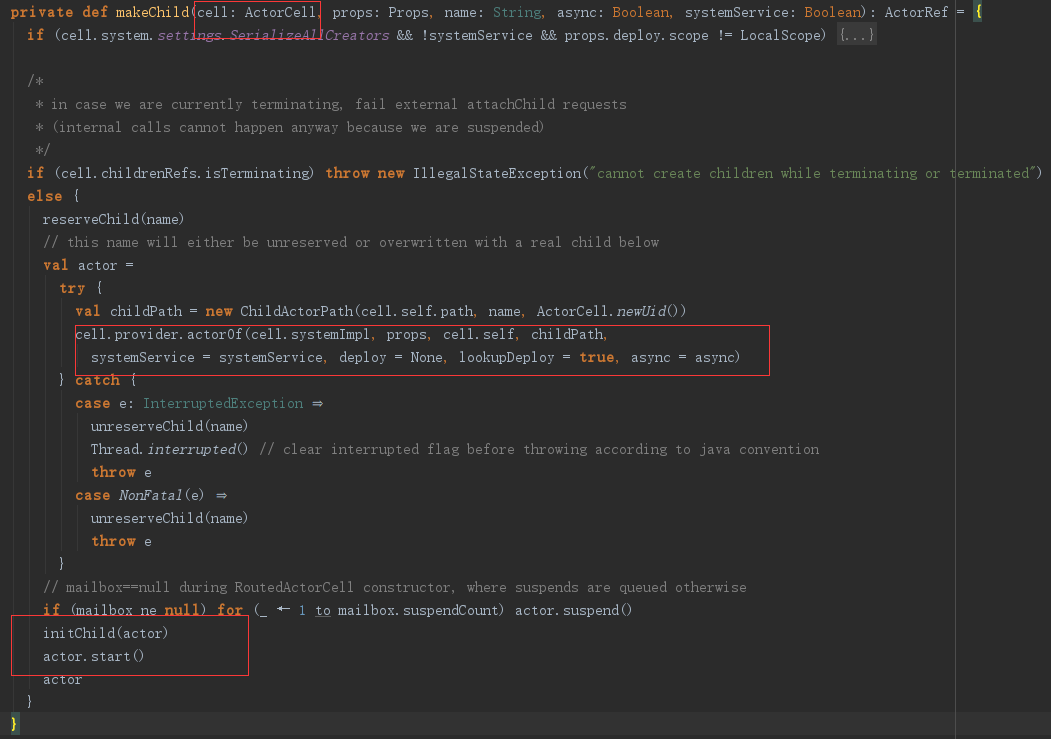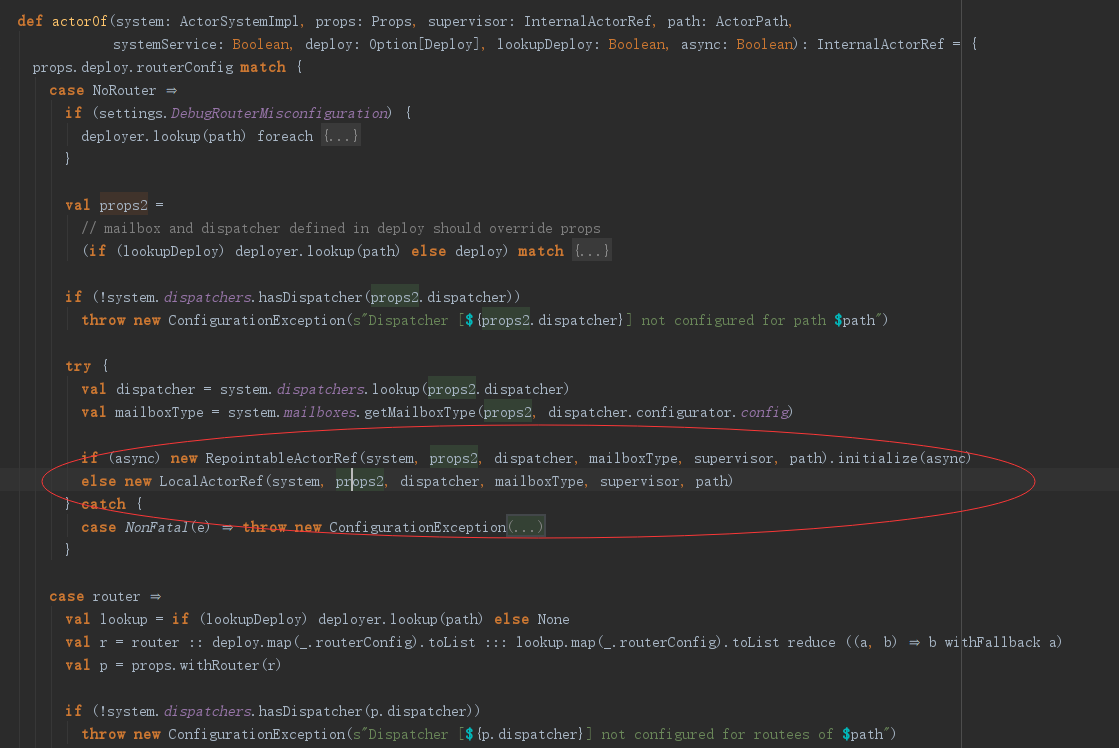Akka源码分析-Actor创建
上一篇博客我们介绍了ActorSystem的创建过程,下面我们就研究一下actor的创建过程。
val system = ActorSystem("firstActorSystem",ConfigFactory.load())
val helloActor= system.actorOf(Props(new HelloActor),"HelloActor")
helloActor ! "Hello"
普通情况下,我们一般使用ActorSystem的actorOf来创建actor,当然通过上一篇博客的介绍,我们已经知道actorOf是继承自ActorRefFactory的函数。
def actorOf(props: Props, name: String): ActorRef =
if (guardianProps.isEmpty) guardian.underlying.attachChild(props, name, systemService = false)
else throw new UnsupportedOperationException(
s"cannot create top-level actor [$name] from the outside on ActorSystem with custom user guardian")
也比较简单,就是判断一下guardianProps是不是为空,为空则调用guardian.underlying.attachChild方法创建一个ActorRef。new ActorSystemImpl(name, appConfig, cl, defaultEC, None, setup).start() 这段代码显示在创建ActorSystemImpl时,guardianProps一定为空,具体guardianProps的作用我们暂时先忽略。
def guardian: LocalActorRef = provider.guardian /** * Reference to the supervisor used for all top-level user actors. */ def guardian: LocalActorRef
通过定位guardian我们发现这是一个LocalActorRef,而且通过官方源码的说明可以看出,这是一个root监督者,用来监督所有用户创建的actor。Akka的actor是按照树状结构创建,都是有一定层级的,actor的路径一般都是/user/actorParent1/actorChild1,其中guardian是user的位置。
/** * Local (serializable) ActorRef that is used when referencing the Actor on its "home" node. * * INTERNAL API */ private[akka] class LocalActorRef private[akka] ( _system: ActorSystemImpl, _props: Props, _dispatcher: MessageDispatcher, _mailboxType: MailboxType, _supervisor: InternalActorRef, override val path: ActorPath) extends ActorRefWithCell with LocalRef
上面是LocalActorRef的定义。上一篇博客我们也介绍了provider的创建过程,它默认是一个LocalActorRefProvider,那就可以找到guardian具体创建的过程了。
override lazy val guardian: LocalActorRef = {
val cell = rootGuardian.underlying
cell.reserveChild("user")
val ref = new LocalActorRef(system, system.guardianProps.getOrElse(Props(classOf[LocalActorRefProvider.Guardian], guardianStrategy)),
defaultDispatcher, defaultMailbox, rootGuardian, rootPath / "user")
cell.initChild(ref)
ref.start()
ref
}
分析上面的代码我们看到,LocalActorRef创建时传入了几个非常重要的参数:defaultDispatcher、defaultMailbox、rootGuardian和rootPath / "user"。之所以重要,是因为通过它们我们可以再深入actor的创建过程。Dispatcher和mailbox都是actor运行非常重要的概念,其中mailbox负责存储actor收到的消息,dispatcher负责从mailbox取消息,分配线程给actor执行具体的业务逻辑。我们逐一进行简要分析。
/** * The one and only default dispatcher. */ def defaultGlobalDispatcher: MessageDispatcher = lookup(DefaultDispatcherId)
/** * The id of the default dispatcher, also the full key of the * configuration of the default dispatcher. */ final val DefaultDispatcherId = "akka.actor.default-dispatcher"
通过追踪defaultDispatcher的创建,我们最终定位到了上面这段代码,很明显是根据默认配置创建了akka.actor.default-dispatcher对应的MessageDispatcher实例。那么akka.actor.default-dispatcher究竟是什么呢?这个得从reference.conf里面看一下。
default-dispatcher {
# Must be one of the following
# Dispatcher, PinnedDispatcher, or a FQCN to a class inheriting
# MessageDispatcherConfigurator with a public constructor with
# both com.typesafe.config.Config parameter and
# akka.dispatch.DispatcherPrerequisites parameters.
# PinnedDispatcher must be used together with executor=thread-pool-executor.
type = "Dispatcher"
# Which kind of ExecutorService to use for this dispatcher
# Valid options:
# - "default-executor" requires a "default-executor" section
# - "fork-join-executor" requires a "fork-join-executor" section
# - "thread-pool-executor" requires a "thread-pool-executor" section
# - "affinity-pool-executor" requires an "affinity-pool-executor" section
# - A FQCN of a class extending ExecutorServiceConfigurator
executor = "default-executor"
# This will be used if you have set "executor = "default-executor"".
# If an ActorSystem is created with a given ExecutionContext, this
# ExecutionContext will be used as the default executor for all
# dispatchers in the ActorSystem configured with
# executor = "default-executor". Note that "default-executor"
# is the default value for executor, and therefore used if not
# specified otherwise. If no ExecutionContext is given,
# the executor configured in "fallback" will be used.
default-executor {
fallback = "fork-join-executor"
}
}
很明显这是一个fork-join-executor,那么fork-join-executor具体是如何完成实例的创建呢?从lookup这段代码来看,是通过MessageDispatcherConfigurator来构造的,根据类名来猜,它应该是读取配置,然后创建MessageDispatcher类的实例的。那么MessageDispatcherConfigurator具体是什么呢?
abstract class MessageDispatcherConfigurator(_config: Config, val prerequisites: DispatcherPrerequisites) {
val config: Config = new CachingConfig(_config)
/**
* Returns an instance of MessageDispatcher given the configuration.
* Depending on the needs the implementation may return a new instance for
* each invocation or return the same instance every time.
*/
def dispatcher(): MessageDispatcher
def configureExecutor(): ExecutorServiceConfigurator = {
def configurator(executor: String): ExecutorServiceConfigurator = executor match {
case null | "" | "fork-join-executor" ⇒ new ForkJoinExecutorConfigurator(config.getConfig("fork-join-executor"), prerequisites)
case "thread-pool-executor" ⇒ new ThreadPoolExecutorConfigurator(config.getConfig("thread-pool-executor"), prerequisites)
case "affinity-pool-executor" ⇒ new AffinityPoolConfigurator(config.getConfig("affinity-pool-executor"), prerequisites)
case fqcn ⇒
val args = List(
classOf[Config] → config,
classOf[DispatcherPrerequisites] → prerequisites)
prerequisites.dynamicAccess.createInstanceFor[ExecutorServiceConfigurator](fqcn, args).recover({
case exception ⇒ throw new IllegalArgumentException(
("""Cannot instantiate ExecutorServiceConfigurator ("executor = [%s]"), defined in [%s],
make sure it has an accessible constructor with a [%s,%s] signature""")
.format(fqcn, config.getString("id"), classOf[Config], classOf[DispatcherPrerequisites]), exception)
}).get
}
config.getString("executor") match {
case "default-executor" ⇒ new DefaultExecutorServiceConfigurator(config.getConfig("default-executor"), prerequisites, configurator(config.getString("default-executor.fallback")))
case other ⇒ configurator(other)
}
}
}
MessageDispatcherConfigurator代码不是太长,简单浏览一下代码就会发现,fork-join-executor对应了ForkJoinExecutorConfigurator。这个类是一个抽象类,里面有一个dispatcher函数返回MessageDispatcher,那么究竟是哪个子类实现了这个方法呢?我们再来看一下lookupConfigurator的具体代码,就会发现其中有一段configuratorFrom(config(id))代码非常可疑,它创建了MessageDispatcherConfigurator类的一个实例。
private def lookupConfigurator(id: String): MessageDispatcherConfigurator = {
dispatcherConfigurators.get(id) match {
case null ⇒
// It doesn't matter if we create a dispatcher configurator that isn't used due to concurrent lookup.
// That shouldn't happen often and in case it does the actual ExecutorService isn't
// created until used, i.e. cheap.
val newConfigurator =
if (cachingConfig.hasPath(id)) configuratorFrom(config(id))
else throw new ConfigurationException(s"Dispatcher [$id] not configured")
dispatcherConfigurators.putIfAbsent(id, newConfigurator) match {
case null ⇒ newConfigurator
case existing ⇒ existing
}
case existing ⇒ existing
}
}
private def configuratorFrom(cfg: Config): MessageDispatcherConfigurator = {
if (!cfg.hasPath("id")) throw new ConfigurationException("Missing dispatcher 'id' property in config: " + cfg.root.render)
cfg.getString("type") match {
case "Dispatcher" ⇒ new DispatcherConfigurator(cfg, prerequisites)
case "BalancingDispatcher" ⇒
// FIXME remove this case in 2.4
throw new IllegalArgumentException("BalancingDispatcher is deprecated, use a BalancingPool instead. " +
"During a migration period you can still use BalancingDispatcher by specifying the full class name: " +
classOf[BalancingDispatcherConfigurator].getName)
case "PinnedDispatcher" ⇒ new PinnedDispatcherConfigurator(cfg, prerequisites)
case fqn ⇒
val args = List(classOf[Config] → cfg, classOf[DispatcherPrerequisites] → prerequisites)
prerequisites.dynamicAccess.createInstanceFor[MessageDispatcherConfigurator](fqn, args).recover({
case exception ⇒
throw new ConfigurationException(
("Cannot instantiate MessageDispatcherConfigurator type [%s], defined in [%s], " +
"make sure it has constructor with [com.typesafe.config.Config] and " +
"[akka.dispatch.DispatcherPrerequisites] parameters")
.format(fqn, cfg.getString("id")), exception)
}).get
}
}
而进入到configuratorFrom函数就会发现,它根据配置的type字段分别创建不同的MessageDispatcherConfigurator,而前面的配置文件中type是Dispatcher。那就对应了DispatcherConfigurator,这又是一个什么类呢?它是一个MessageDispatcherConfigurator子类,并且实现了dispatcher函数。这个函数创建了最终的MessageDispatcher。这个类又调用了configureExecutor()方法传入了一个ExecutorServiceConfigurator实例,根据前面的代码我们知道这就是ForkJoinExecutorConfigurator。
/**
* Configurator for creating [[akka.dispatch.Dispatcher]].
* Returns the same dispatcher instance for each invocation
* of the `dispatcher()` method.
*/
class DispatcherConfigurator(config: Config, prerequisites: DispatcherPrerequisites)
extends MessageDispatcherConfigurator(config, prerequisites) {
private val instance = new Dispatcher(
this,
config.getString("id"),
config.getInt("throughput"),
config.getNanosDuration("throughput-deadline-time"),
configureExecutor(),
config.getMillisDuration("shutdown-timeout"))
/**
* Returns the same dispatcher instance for each invocation
*/
override def dispatcher(): MessageDispatcher = instance
}
自此一个MessageDispatcher创建完成。这创建过程真是曲折蜿蜒啊,哈哈哈。不过有些是为了抽象、封装,有些是为了可配置,稍微复杂了点。下面就分析defaultMailbox如何创建的。
private lazy val defaultMailbox = system.mailboxes.lookup(Mailboxes.DefaultMailboxId)
跟dispatcher有点类似,也是同样的lookup创建的,当然这也是为了可配置(DefaultMailboxId = "akka.actor.default-mailbox")。跟踪lookup来到以下代码。
private def lookupConfigurator(id: String): MailboxType = {
mailboxTypeConfigurators.get(id) match {
case null ⇒
// It doesn't matter if we create a mailbox type configurator that isn't used due to concurrent lookup.
val newConfigurator = id match {
// TODO RK remove these two for Akka 2.3
case "unbounded" ⇒ UnboundedMailbox()
case "bounded" ⇒ new BoundedMailbox(settings, config(id))
case _ ⇒
if (!settings.config.hasPath(id)) throw new ConfigurationException(s"Mailbox Type [${id}] not configured")
val conf = config(id)
val mailboxType = conf.getString("mailbox-type") match {
case "" ⇒ throw new ConfigurationException(s"The setting mailbox-type, defined in [$id] is empty")
case fqcn ⇒
val args = List(classOf[ActorSystem.Settings] → settings, classOf[Config] → conf)
dynamicAccess.createInstanceFor[MailboxType](fqcn, args).recover({
case exception ⇒
throw new IllegalArgumentException(
s"Cannot instantiate MailboxType [$fqcn], defined in [$id], make sure it has a public" +
" constructor with [akka.actor.ActorSystem.Settings, com.typesafe.config.Config] parameters",
exception)
}).get
}
if (!mailboxNonZeroPushTimeoutWarningIssued) {
mailboxType match {
case m: ProducesPushTimeoutSemanticsMailbox if m.pushTimeOut.toNanos > 0L ⇒
warn(s"Configured potentially-blocking mailbox [$id] configured with non-zero pushTimeOut (${m.pushTimeOut}), " +
s"which can lead to blocking behavior when sending messages to this mailbox. " +
s"Avoid this by setting `$id.mailbox-push-timeout-time` to `0`.")
mailboxNonZeroPushTimeoutWarningIssued = true
case _ ⇒ // good; nothing to see here, move along, sir.
}
}
mailboxType
}
mailboxTypeConfigurators.putIfAbsent(id, newConfigurator) match {
case null ⇒ newConfigurator
case existing ⇒ existing
}
case existing ⇒ existing
}
}
跟dispatcher创建有点类似,就是先查找有没有,没有就创建一个,只不过不同的是,这段代码只是创建了MailboxType,而没有直接创建真正的消息队列,不过后面再具体分析。那akka.actor.default-mailbox究竟是什么呢?同样需要翻reference.conf配置
default-mailbox {
# FQCN of the MailboxType. The Class of the FQCN must have a public
# constructor with
# (akka.actor.ActorSystem.Settings, com.typesafe.config.Config) parameters.
mailbox-type = "akka.dispatch.UnboundedMailbox"
# If the mailbox is bounded then it uses this setting to determine its
# capacity. The provided value must be positive.
# NOTICE:
# Up to version 2.1 the mailbox type was determined based on this setting;
# this is no longer the case, the type must explicitly be a bounded mailbox.
mailbox-capacity = 1000
# If the mailbox is bounded then this is the timeout for enqueueing
# in case the mailbox is full. Negative values signify infinite
# timeout, which should be avoided as it bears the risk of dead-lock.
mailbox-push-timeout-time = 10s
# For Actor with Stash: The default capacity of the stash.
# If negative (or zero) then an unbounded stash is used (default)
# If positive then a bounded stash is used and the capacity is set using
# the property
stash-capacity = -1
}
在lookupConfigurator函数中有一段很重要的代码:dynamicAccess.createInstanceFor[MailboxType](fqcn, args)。它同样调用了dynamicAccess创建了一个MailboxType的实例,实例的类型就是mailbox-type的值。那么akka.dispatch.UnboundedMailbox究竟又是怎么样的呢?
/**
* MailboxType is a factory to create MessageQueues for an optionally
* provided ActorContext.
*
* <b>Possibly Important Notice</b>
*
* When implementing a custom mailbox type, be aware that there is special
* semantics attached to `system.actorOf()` in that sending to the returned
* ActorRef may—for a short period of time—enqueue the messages first in a
* dummy queue. Top-level actors are created in two steps, and only after the
* guardian actor has performed that second step will all previously sent
* messages be transferred from the dummy queue into the real mailbox.
*/
trait MailboxType {
def create(owner: Option[ActorRef], system: Option[ActorSystem]): MessageQueue
}
trait ProducesMessageQueue[T <: MessageQueue]
/**
* UnboundedMailbox is the default unbounded MailboxType used by Akka Actors.
*/
final case class UnboundedMailbox() extends MailboxType with ProducesMessageQueue[UnboundedMailbox.MessageQueue] {
def this(settings: ActorSystem.Settings, config: Config) = this()
final override def create(owner: Option[ActorRef], system: Option[ActorSystem]): MessageQueue =
new UnboundedMailbox.MessageQueue
}
源码中对MailboxType的描述也非常清楚。这是一个工厂类,是用来创建MessageQueues的,只不过这个名字非常奇怪,为啥不叫MailboxFactory呢,或者MessageQueueFactory?鬼知道啊。
MailboxType的创建过程也比较清楚了,具体UnboundedMailbox.MessageQueue的类是怎么样的,继承结构又是怎么样的,我们就不再继续深入分析了。
下面我们来看guardian调用的第一个方法underlying,这个词的意思是表面下的,下层的,它是一个ActorCell类型。看看它继承的类,貌似还挺复杂的。

最终调用了ActorCell的attachChild方法,而这个方法调用了makeChild,最重要的代码如下面红色框表示,调用了ActorCell.provider的actorOf,通过initChild加入了当前的children,调用actor的start方法,actor创建结束。children具体的数据结构我们暂时也不再深入研究。

不过,通过ActorCell的构造函数以及继承关系我们知道上面代码中的provider就是ActorSystemImpl中的provider,也就是默认的LocalActorRefProvider,那我们还得回溯代码去看具体的actorOf函数。

由于代码很长,可以将无关的代码折叠起来。如上图,会先判断当前有没有router,很显然没有;又用deployer中的配置,判断有没有对当前的dispatcher和mailboxType进行覆盖,很显然也没有,一切保持原样。最后一个if语句,如果async为true则创建RepointableActorRef,根据上面的代码分析,async是true。RepointableActorRef创建完成之后,调用了initialize完成初始化。
/**
* Initialize: make a dummy cell which holds just a mailbox, then tell our
* supervisor that we exist so that he can create the real Cell in
* handleSupervise().
*
* Call twice on your own peril!
*
* This is protected so that others can have different initialization.
*/
def initialize(async: Boolean): this.type =
underlying match {
case null ⇒
swapCell(new UnstartedCell(system, this, props, supervisor))
swapLookup(underlying)
supervisor.sendSystemMessage(Supervise(this, async))
if (!async) point(false)
this
case other ⇒ throw new IllegalStateException("initialize called more than once!")
}
/**
* This method is supposed to be called by the supervisor in handleSupervise()
* to replace the UnstartedCell with the real one. It assumes no concurrent
* modification of the `underlying` field, though it is safe to send messages
* at any time.
*/
def point(catchFailures: Boolean): this.type
在initialize中,给supervisor给监督者发发送了一个Supervise消息,以便监督自己;然后调用了point,具体含义可参考官方源码的注释。其实RepointableActorRef还是比较麻烦的,读者有兴趣可以自己研究,不过我个人感觉它应该主要是为了防止在actor重新创建或新建的过程中消息不会丢失设计的。具体我也没有太明白,后面再深入研究了。
到这里system.actorOf基本就算执行结束,它返回了一个InternalActorRef,这是ActorRef的一个子类。这样,后续的代码就可以使用 ! 或tell给actor发送消息了。不过我们虽然大致研究了actor的创建过程,但并没有进入深入的研究,比如,我们自身的actor的实现类是在什么时候初始化的并不知道。当然这并不妨碍我们继续研究akka的源码。



